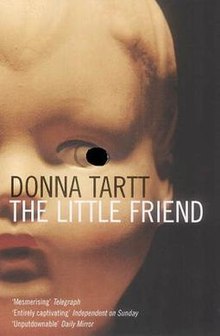The Little Friend
 First edition cover | |
| Author | Donna Tartt |
|---|---|
| Cover artist | Chip Kidd |
| Language | English |
| Genre | Fiction novel |
| Publisher | Knopf |
Publication date | October 22, 2002 |
| Publication place | United States |
| Media type | Print (Hardcover and Paperback) |
| Pages | 576 pp |
| ISBN | 0-679-43938-2 |
| OCLC | 49603052 |
| 813/.54 21 | |
| LC Class | PS3570.A657 L58 2002 |
The Little Friend is the second novel by Donna Tartt, initially published by Alfred A. Knopf on October 22, 2002, a decade after her first novel, The Secret History.
Superficially, The Little Friend is a mystery adventure, centered on a young girl, Harriet Cleve Dufresnes, living in Mississippi in the early 1970s and her implicit anxieties about the unexplained death of her brother Robin, who was killed by hanging in 1964 at the age of nine.[1] The dynamics of Harriet's extended family are a strong focus of the novel, as are the lifestyles and customs of contrasting Southerners.
Speaking to The Guardian in 2002, Tartt described The Little Friend as "a frightening, scary book about children coming into contact with the world of adults in a frightening way." She told the interviewer that The Little Friend was intentionally different from The Secret History, stating "I wanted to take on a completely different set of technical problems. The Secret History was all from the point of view of Richard, a single camera, but the new book is symphonic, like War And Peace. That's widely thought to be the most difficult form."[1]
Plot
In the 1960s, on mother's day, Robin, the eldest and only son of the Dufresnes, a white family living in Mississippi, is found hanging from a tree on the family property. Only nine years old at the time of his death, his murder causes his mother, Charlotte, to sink into a depression and his father, Dixon, to abandon the family on the pretext of work.
Twelve years later his two younger sisters, Allison and Harriet, are now sixteen and twelve years old. Harriet, the youngest child, is considered particularly difficult as she is intensely smart and has also developed a morbid fascination with her brother and also with the past, believing that her matrilineal family, the Cleves, were once incredibly wealthy and successful.
Reception
Both Ruth Franklin of The New Republic and A. O. Scott of The New York Times reviewed the book positively. Franklin highlighted Tartt's literary "obsess[ion] with crimes that go unpunished".[2] Scott described the book as "tragic, fever-dream realism."[3]
The novel won the WH Smith Literary Award and was shortlisted for the Orange Prize for Fiction in 2003.[citation needed] The jacket design is by Chip Kidd.[citation needed]
References
External links
- David Hare review in Guardian Unlimited (October 27, 2002)
- Oxonian Review: "Donna Tartt's Confused Little Friend"
- Video
- Audio
